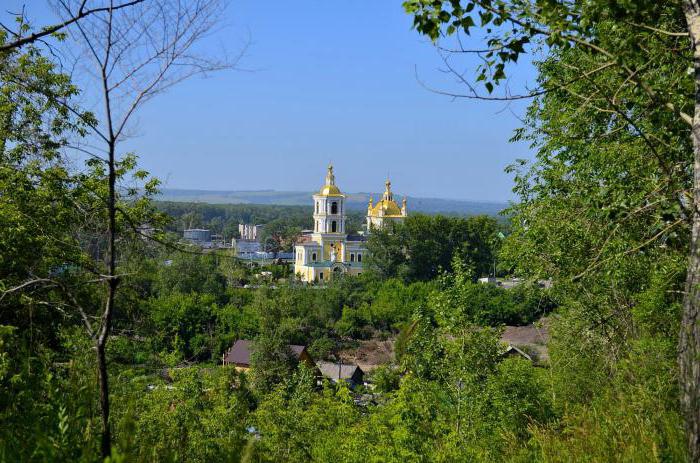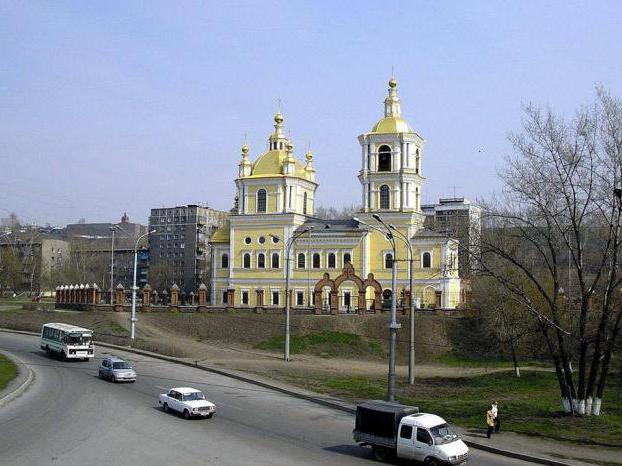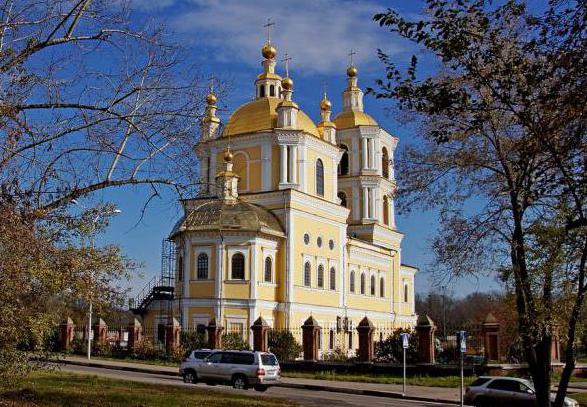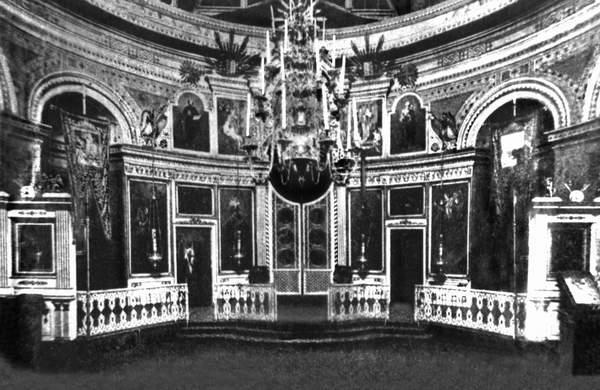Novokuznetsk, Holy Transfiguration Cathedral: where is located, photo
Novokuznetsk Savior Transfiguration Cathedral - onefrom the oldest Orthodox churches in the city. Located on the banks of the Tom River, a beautiful architectural structure with a forty-meter bell tower is visible to all visitors to Novokuznetsk. The Transfiguration Cathedral for many years was the tallest building not only in the city, but also in Siberia.

Construction of a wooden church
The story begins in 1620, whenThe first Orthodox church was erected on the territory of the Kuznetsk jail near the chapel, built in 1618 with the participation of the priest Anikidim. The church was called Preobrazhenskaya (in the name of the Transfiguration of the Lord).
So received the Novokuznetsk Savior Transfigurationcathedral for the first time. This was facilitated by the fact that in 1622 the prison gained the status of the city and the coat of arms. The cathedral looked like many churches in Siberia: the traditional North Russian tent style was then a symbol of Russia.
The first rector - Ivashka Ivanov, beforewho served as a clerk in the Arkhangelsk Cathedral in Moscow, arrived at the temple, the Royal Gates, icons and garments were also delivered there. Service began. Priests of the cathedral in the XVII century helped protect the raids of nomad Tatar Kuznetsky prison.
XVIII century: status change
In 1718 Peter I was granted a three-metera cross from a tree in the Transfiguration Cathedral. Novokuznetsk then celebrated its centenary. A few years later the cathedral was rebuilt, after a terrible fire in 1734.
Only in the XVIII century the wooden church received its full name and status. Until the beginning of the XIX century it was the main cathedral of the Kuznetsk district, and after all - the Kuznetsk deanery, united 20 parishes.

Transfiguration in stone
By 1791 the wooden church had become worthless. It was decided to build a stone building. Archbishop of Tobolsk and Siberian Varlaam blessed, Protopriest Efimius Vikulovsky ordered the Irkutsk artel Pochekunin, who laid the foundation and the first stage of construction in May 1792.
The first floor contained two altars - the Forerunners andThe baptizer of the Lord John and in honor of St. Nicholas of Myra, he consecrated them in 1801, Archpriest Yakov Aramilsky. On the second floor, the main throne of the Transfiguration of the Lord was placed.
The pace of construction was dependent on the amount of money received and other assistance from parishioners of the temple. Finally, after a long 43 years, the city of Novokuznetsk decorated the Transfiguration Cathedral.
The long term of erection affected the architecturalstyle, which included the classical traditions of building temples and elements of the late Siberian Baroque. Restraint of the decorative development of the facade is combined with an abundance of Baroque chapters, which gives the cathedral individuality and uniqueness. Masonry was completed in 1830, in 1831 finished the finish. Service for the solemn consecration of the temple was held in the summer of 1835. This was the second time that Novokuznetsk received the Savior's Transfiguration Cathedral.

Tests of the beginning of the XIX century
Several decades passed. All this time decorated the Transfiguration Cathedral of Novokuznetsk and its surroundings, its tall bell tower was visible from afar.
The beginning of the century the temple met several dilapidated andaffected by the earthquake in June 1898. By 1907, its major repairs were completed: paintings and icons were updated, the iconostasis, crosses and bulbs were gilded.
Tests for the temple began in late 1919,when during the anti-Kolchak speeches the Savior-Transfiguration Cathedral suffered greatly. Novokuznetsk, where the Odigitriev Church is also located (known for the fact that Dostoevsky was married in it) was practically destroyed and burned by a detachment of anarchists from the Altai partisans under the leadership of Rogov G.F. and Novoselov I.P.
The temple was ruined, almost completely burnt,The bells were thrown to the ground. For seven years, the cathedral was renovated on the first floor, the most affected by the fire, resumed worship services.
But not for long the church accepted the parishioners. In the twenties, he was captured by the "Renovationists". In 1929, they opened a geological museum in this building. It was already difficult to recognize the once-beautiful Spaso-Preobrazhensky Cathedral. Novokuznetsk lost the symbol and spiritual foundation.
In 1933-1935 the chairman of Kuznetskythe executive committee of Vorobyov and the detachment of the Komsomol members completely plundered the church, again dropped heavy bells, dismantled the greater part of the bell tower, crushed the commanders, crushed the crosses.
The construction was planned to be used as a museum,but the plans were never implemented. In the empty building for two years there was a school of combine operators, a couple of years later - a bakery. After the war the building of the cathedral was completely abandoned for several decades.

The second half of the XIX century. Long oblivion
The church stood idle for many years. In the sixties the leadership of Novokuznetsk considered the plan for turning the cathedral into a restaurant called "Old Fortress", but it did not realize it.
In the late 80-ies on the building again turnedattention, having conceived placing in it of an organ hall. Almost at the same time, Orthodox Christians submitted another appeal to the city Council of People's Deputies on the transfer of the temple to them. They have done this for many years and received refusals.
In 1988, the city council decided to transfer the cathedral to the Orthodox community of Novokuznetsk, despite the fact that experts spoke of it as an ideal premise for the organ hall.

Restoration of the temple
Since 1989, the revival of the temple began, restored the parish, launched restoration and repair. Already in 1991, before the completion of the work, divine services were resumed.
The first priest of the renovated church was the priest Boris Borisov. About how the restoration of the Transfiguration Cathedral of Novokuznetsk, the photo remained small.
Since 1994, around the temple erected scaffolding for grouting walls. Three years later, the main dome and cupola of the bell tower were covered with copper, the floor of the first floor was covered with heated marble.
In 1999, finishing works were completed,the scaffolding was removed, the domes were covered with gilding. And in 2004 they completed the restoration works, as well as the painting of the cathedral. Only fifteen years have passed and again could see the Transfiguration Cathedral of Novokuznetsk. The address at the church remained the same: st. Waterfall, house 18. The cathedral with a 400-year history celebrated its next rebirth and once again became the center of the Kuznetsk deanery.
</ p>




